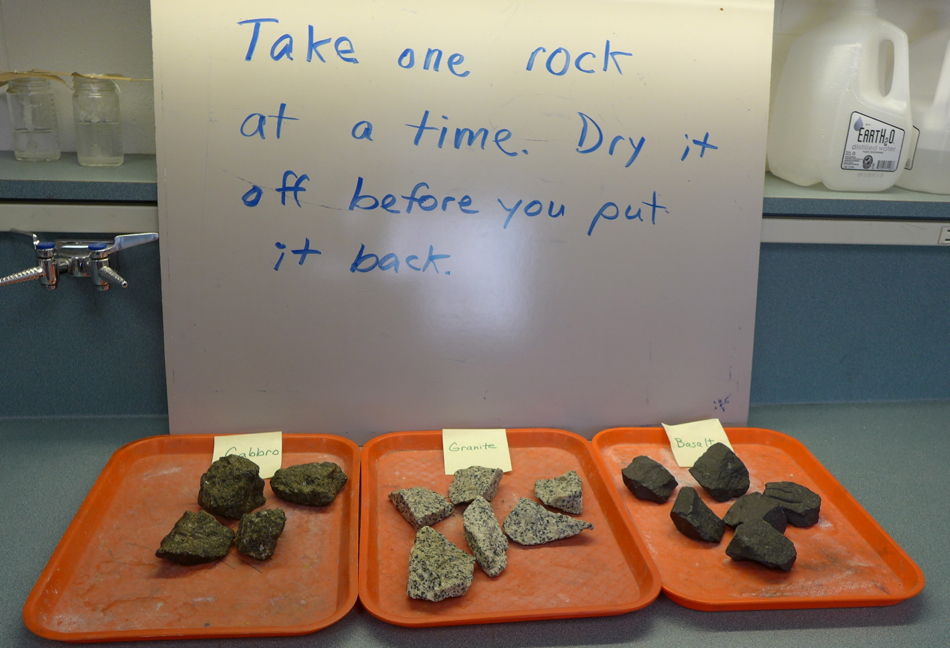

|
Click here to print out a copy of the handout (pdf).
Above: These are the materials needed to complete the lab. The tongs are optional (used to remove rock from aluminum container). A plastic/paper cup can be used in place of the smaller beaker. You will also need samples of granite, gabbro, and basalt that are smaller than 100 cm3, unless you have larger graduated cylinders (see photo at bottom of this web page). If you don't have aluminum overflow containers, make your own (photo). IMPORTANT: Students who missed this lab should make arrangements with Benson to do the lab during lunch within one week. Read the description below so that you'll know what you're doing. Purpose: Students will determine the density of three different kinds of igneous rocks (2 samples of each). They will record their data and calculations on the handout . Students should work in groups of 2-3, and each group should start with one rock - basalt, gabbro, or granite. They will determine the mass and volume as demonstrated at the start of class (see below), and then calculate the density. 1. Obtain a sample of gabbro, basalt, or granite - only take one sample at a time. Determine its mass (round to nearest tenth of a gram). The gabbro in this photo has a mass of 223.6 grams (photo). 2. Fill a 1 L beaker with water. Place a spill cup (smaller beaker) beneath the spout of the aluminum overflow container. Pour water from the 1 L beaker into the aluminum container until it starts to overflow (photo). When it has stopped dripping (photo), remove the spill cup and put a 400 ml beaker in its place (photo). 3. Lower the rock sample as shown in this photo - keep your fingers out of the water. Gently drop the rock as shown here. The water will overflow into the beaker. Keep the beaker beneath the spout until it stops dripping (photo). 4. The volume of the water that overflowed is equal to the volume of the rock sample in the aluminum container (photo). To get a more accurate reading of the volume (round to nearest whole number), pour the water that has overflowed from the 400 L beaker into a 100 mL graduated cylinder. In this case (photo) the volume of the rock was 84 mL (or 84 cm3 photo ). 5. DENSITY = MASS divided by VOLUME . . . For the sample of gabbro shown in the photos, 223.6 g divided by 84 cm3 = 2.7 g/cm3. 6. Use the tongs to remove the rock sample from the water. Dry it off, return it to the tray, and then repeat procedures 1-5 with the next rock. Students' results will vary because not all granites, basalts, and gabbros contain exactly the same minerals. According to About.com the density of granite ranges from 2.6-2.7 g/cm3 and basalt is 2.8-3.0 g/cm3. Since gabbro and basalt are made of the same minerals, their densities are similar. Gabbro's density ranges from 2.7-3.3 g/cm3. Follow-Up: The day after the lab is a good time to discuss the significance of rock densities. Here are some questions for discussion: 1. What do you think causes some rock types to have higher densities than others? (Assuming there are no air pockets in the rock, the types of minerals will determine the density. Granite contains lots of quartz and feldspar - both fairly light minerals, whereas basalt and gabbro are made of heavier minerals.) 2. Consider a zone of subduction. Why is it that when ocean crust and continental crust collide, the ocean crust always goes under the continental crust, and not vice versa? (Ocean crust is made of basalt and continental crust is mostly granite. Basalt is more dense.) 3. Which would be less dense - granite, or magma that contains the same minerals as granite? (The molten minerals would less dense for the same reason hot water is less dense than cold water, and hot air is less dense than cold air. Molecules that are moving faster tend to be farther apart. This is why molten material tends to melt its way to the surface. It's a density thing!) 4. I have a large scrap of gabbro counter-top, and I ask students, "How would you determine the density of this piece of gabbro ?" (They would need to find the mass, and then measure the length, width, and height to determine the volume in cm3 -> photo.) The slab weighs 17.8 lbs. so the density is 3.0 g/cm3 (photo.) 5. I have a large irregular sample of porphyry that fits in the aluminum overflow container, but has a volume that exceeds 100 mL. I ask, "How would you determine the density of this, using the equipment used in your lab?" (They would need to pour 100 mL of the overflow into the graduated cylinder, empty the cylinder, and repeat, keeping track of the total amount poured into the cylinder.)
 |
